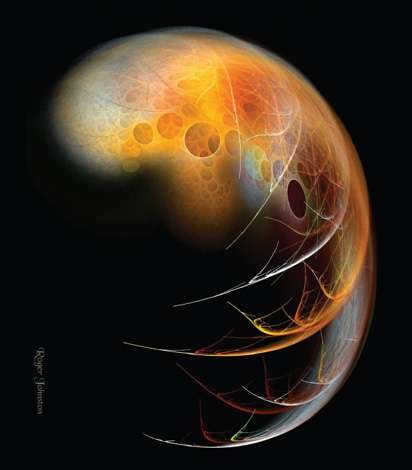Chaos theory ..
In the past, chaos represented the unknown, the world of spirits - threatening and nightmarish visions that reflected Man's fear of the uncontrollable and his need to shape and structure his apprehensions. Today, the theory of chaos represents an exciting field, in full expansion, which involves the study of the most diverse phenomena showing a dependence on initial conditions. Although chaotic behavior often seems random and unpredictable, it often obeys strict mathematical rules derived from equations that can be shaped and studied.

Computer graphics is an important research tool to help study chaos. From chaotic toys with random flashing lights to swirls and swirls of cigarette smoke, chaotic behavior is usually irregular and disordered; other examples include meteorological models, certain cardiac and neurological activities, the Stock Exchange and some electrical computer networks. Chaos theory has also often been applied to a wide range of visual art works.

Mathematical Model of Chaos, created by Roger A. Johnston. Although the chaotic behavior may seem "random" and unpredictable, it often obeys mathematical rules derived from equations that can be studied. Very small changes in initial conditions can lead to very different results. © Dunod, rights reserved
Mathematical Model of Chaos, created by Roger A. Johnston. Although the chaotic behavior may seem "random" and unpredictable, it often obeys mathematical rules derived from equations that can be studied. Very small changes in initial conditions can lead to very different results. © Dunod, rights reserved
In science, there are some clear and famous examples of chaotic physical systems, such as the thermal convection of fluids, oscillating chemical reactions, fluid dynamics, population growth, the impact of particles on a wall subjected to regular vibration. or non-linear electrical circuits.
Birth of chaos theory
The theory of chaos was born around 1900, when mathematicians like Jacques Salomon Hadamard (1865-1963) and Jules Henri Poincaré (1854-1912) studied the complex trajectories of moving bodies. In the early 1960s, Edward Lorenz (1917-2008), a meteorological researcher at the Massachusetts Institute of Technology, used a system of equations to model convection in the atmosphere. In spite of the simplicity of his formulas, he quickly identified one of the characteristics of chaos - namely, that extremely minute modifications of the initial conditions lead to different and unpredictable results.
Butterfly Effect
In a 1963 article, Lorenz explained that the flapping of a butterfly's wings at one end of the Earth could affect the climate at the other end. Today we call this phenomenon the butterfly effect